INS: Re-inventing the Grocery Industry by Constructing a Global Decentralized Eco-system
Online Grocery Market
The sudden blossoming of grocery market as one of the largest consumer markets in the world comes as a no surprise to many observers who have an eye for insight. The grocery market is forecast to affirmatively touch $8.5 billion by 2020. In 2016, the global grocery market increased by an estimated 16%. For all intents and purposes, this can be seen as a digital tipping point with ‘online’ being the most dominant channel. Online grocery, whose value in 2015 was estimated to be $98 billion, is now expected to dismantle the barrier of $100 billion and position itself at an astonishing $290 billion by 2020.
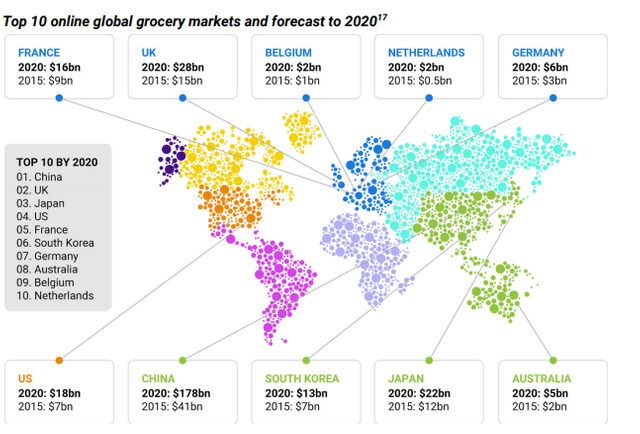
High Market Concentration
High market concentration leads to the phenomenon of towering prices. Top grocery retail corporations undoubtedly control grocery markets. This is markedly prevalent in countries such as Portugal. Not astonishingly, nearly 90% of the nation’s grocery market is controlled by its top 3 retailers.
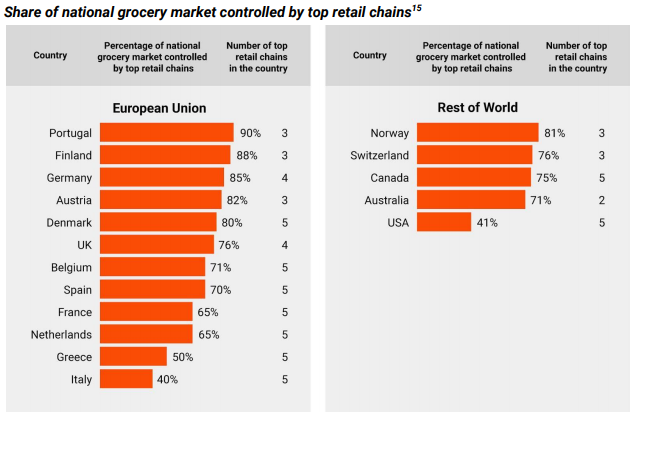
Interrelated Problems
There are two interrelated problems responsible for throwing the grocery market out of tune with time:
1.Existence of retail abuse
2.Prevalence of ineffective trade promotions.
The key stakeholders in the grocery industry are retail chains, manufacturers and consumers. The privilege of retailers in dictating what foods are to be grown and how they are to be processed, packaged, priced and promoted has whipped up the afore-stated major problems. The gravity of the first problem can be explained with a real time scenario.
In the United Kingdom, only four retailers function as a conduit for as many as 7000 manufacturers. The 4 retailers are responsible for selling the products to an estimated 25 million households.
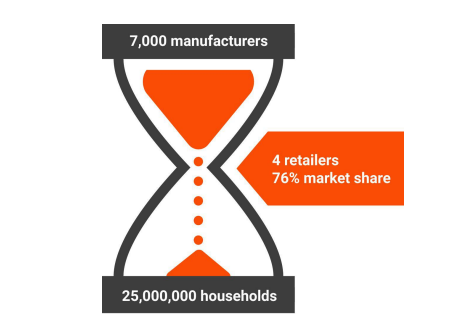
Coming to the gravity of the second problem stated in the earlier paragraph, trade promotion spending constitutes an estimated 17% of manufacturer’s sales. An estimated $500 billion on trade promotions doesn’t reach the consumer. What’s even more astonishing is that nearly 66% of the spend doesn’t generate any positive returns. In many cases, it generates negative returns. This often leads to higher grocery prices. This unfairness is a direct consequence of inefficiency in trade promotions.
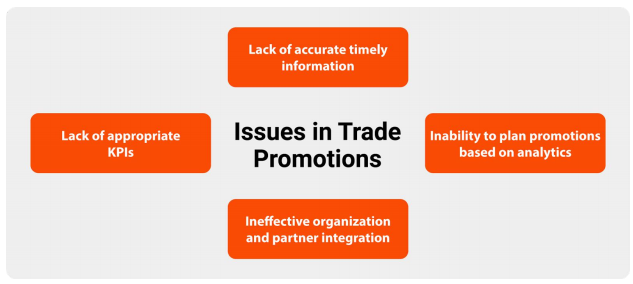
Supply Chain Inefficiencies
Categorically speaking, there are two major inefficiencies plaguing the supply chain eco-system:
1.High Distances Between Manufacturer and Consumers
In the United States of America, the average meal is estimated to travel nearly 1500 miles from farms to plates. If a country imports food, the distance travelled by the food so as to reach the customers is beyond 1500 miles. This high distance between manufacturers and consumers can result in acute financial and ecological consequences. If unattended, the problem may accentuate and cause long term ramifications.
2.Waste In Several Areas of Supply Chain
Food is wasted not only in grocery stores but also in distribution centers. More often than not, perishable food items are thrown during nights. According to a survey, nearly one thirds of 400 million pounds of found served / stocked by supermarkets is wasted annually.
3.Food Miles
Food miles is nothing but the distance food travels from the place it is grown to the place it is consumed. If food is imported, food miles increase.
Facilitating Direct Interaction between Consumers and Manufacturers
Let us now look at the traditional supply chain followed in various Consumer Goods companies such as HUL, Reckitt Benckiser etc.
From Manufacturers, manufactured goods are forwarded to depots. CFAs (Carrying and Forwarding Agents) subsequently forward the manufactured goods from depots to distributors. Distributors have their own modes of transportation to forward the ordered goods from their respective warehouses to wholesalers. More often than not, wholesalers buy the goods in bulk and sell them to retailers. In a nutshell, the intermediaries involved in the entire supply chain process are distributors, wholesalers and retailers.
To facilitate direct interactions between consumers and manufacturers, the intermediaries have to be bypassed. Not only does bypassing intermediaries result in transparent and personalized grocery shopping experiences, but also result in purchases at lower prices. This can be declared as the characteristic of the 21st century consumption and industry experts call it “Consumption 2.0”. This comes as a boon to customers as retailers will no longer push goods that maximize profits.
About INS
INS intends to disrupt the grocery market by facilitating direct interaction between consumers and manufacturers. Ever since its inception in 2013, INS has been successfully assisting manufacturers in implementing be-spoke marketing programs so as to reward their customers directly. It is noteworthy to mention that bespoke marketing programs run on smart contracts and are powered by INS tokens. The very idea of running such marketing programs shall get dismantled if blockchain and smart contracts aren’t leveraged.
As of 2017, INS has signed Memoranda of Understanding (MoU) with some of the largest grocery manufacturers in the world such as:
-Unilever Food Solutions
-Unilever
-Reckitt Benckiser
- Valio
-Mars
-FrieslandCampina
INS purportedly pays obeisance to state of the art methodologies to reduce food miles by allowing consumers to access farmers and local manufacturers. To minimize the incidence of food wastage, INS leverage ‘pull’ system. For your information, in pull system, production orders are initiated as soon as inventory reaches certain level. The concept of excess inventory and out-of-stock are addressed effectively.
Founders’ Experience
The founders of INS had a pleasant first hand and practical experience with Instamart, Russia’s largest venture backed grocery delivery operator. Instamart has been carrying out its operations in Russia for 4 years and has signed contracts with quite a few largest retailers and leading grocery manufacturers of the country. INS diligently identified all the retail abuses and inefficiencies in the industry’s current practices. INS pursued its ambitious vision of establishing a decentralized and fair ecosystem that serves as a conduit between manufacturers and consumers.
In its endeavor to facilitate communication between brands and consumers, ad banners, sampling and co-packaging, traffic generation and targeting etc., and other techniques were effectively deployed.

Demand and Supply Drivers
There is no gainsaying that consumers are becoming more and more inclined to time-saving shopping. Some of the factors responsible for the rapid growth of online grocery retail are as follows:
-Consumer Demographics
-Internet Connectivity with good bandwidth
-Number of working women
-Ever increasing penetration of smartphones
-Consumers’ emphasis on convenience
Traditionally, people had several biases such as wanting to touch and see food and grocery products. It is conspicuous that people are slowly and gradually overcoming such biases. This can be attributed to ‘time’ consciousness in lieu of fast paced lives. Here is a simple yet effective categorization of demand and supply drivers:
Demand Drivers:
-Deplorable road traffic conditions
-Continuous increase in urbanization
-Busy Lifestyle
-Growing middle class paying population
-Great expectations from the thriving economy
Supply Drivers:
-Ascendance of revolutionary mobile technology
-Emergence of automated fulfillment solutions
-State of the art marketplace models that require hardly any capital expenditure
-Affordability and prompt delivery due to crowdsourcing economy
The top four drivers which influence the purchasing decisions of consumers are:
1.Price of the product
2.Quality of the product
3.Convenience
4.Special Promotions
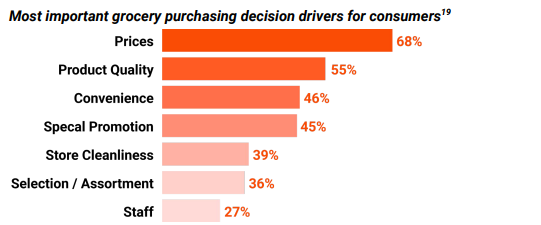
Not only will INS enable customers directly purchase their products from manufacturers, but also receive direct rewards.
INS Ecosystem
INS Ecosystem is the official company which produces INS tokens and leverages INS open source cryptographic technologies to facilitate operations. It must be remembered that token holders aren’t bestowed with any voting rights or guaranteed form of dividends. Also, revenue distribution is not in the offing. Participants are required to register on INS platform. As an integral process of registration, the system is known to create both – a user profile and a wallet. The wallet stores all the data in a decentralized database. The wallet serves as a vehicle to interact with other parties and engage in active utilization of smart contracts. INS tokens are placed on cryptographic token exchanges, thereby giving participants enough opportunities to purchase them.
Eco-System Participants
The key stakeholders in the eco-system are enlisted below:
- Platform
- Consumers
- Manufacturers
- Fulfillment center operators, workers and staff
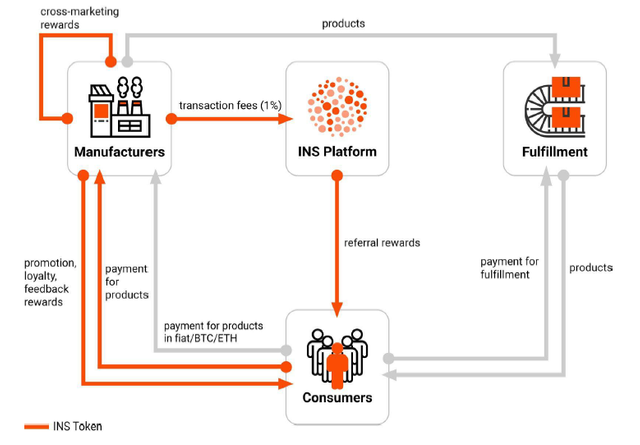
Platform
As mentioned in the earlier paragraphs, INS platform is a decentralized marketplace which allows manufacturers to register themselves and publish their products for sale. Apart from this, the platform has enough provisions that enable manufacturers to promote loyalty programs and organize campaigns. At the end of campaigns and programs, the manufacturers can solicit feedback from consumers.
The roles of INS platform are:
-Token creation
-Token launch
-Fund development and initiate the process of order execution
-Ensure transparency in the order execution process
-Build a fair and secure order initiation model
-Generate smart contracts
-Create effective incentive models so as to encourage other parties to join the INS platform
-Develop active marketing campaigns
-Adhere to regulatory standards
-Design a seamless and effective web interface to bridge the gap between manufacturers and fulfillment centers
Multiple payment methods such as INS tokens, Fiat currencies, BTC, ETH, etc., are supported on the platform.

Manufacturers
As the name implies, manufacturers are companies and individuals that engage in the activity of production. Right from producing fresh produce to groceries and consumable household items, manufacturers can produce anything and everything. Manufacturers can be our neighborhood local farms. They can also be large multinationals such as Coca Cola, Procter & Gamble, Unilever, etc.
The responsibilities of manufacturers are:
1.Publish: They should publish products
2.Deliver: The published products should be delivered to fulfillment centers which cater to the demands of customers
3.Promote: Manufacturers are required to promote the INS ecosystem by bringing traffic via promotions of derived apps.
It is incumbent on the manufacturers to hold certain amount of balance in INS tokens. This is mandatory as manufacturers should be endowed with enough capacity and capability to pay all the types of rewards.
Consumers
To put in layman terms, consumers are either individuals or companies that purchase high quality groceries at affordable prices. Orders are placed on the INS website. Enlisted below are a few of the consumer roles:
1.INS website contains a broad assortment of products listed by manufacturers. Consumers are entitled to browse the website and place orders.
2.They are entitled to various schemes such as promotion, loyalty, referral and feedback rewards.
3.Participate in feedback requests
Fulfillment
There are three key entities which come under the purview of fulfillment.
1.Fulfilment Center Operators
More often than not, fulfillment center operators are the owners of warehouses and delivery fleet. Sometimes, they can also be independent contractors looking after the supply chain process. For all intents and purposes, they are the owners of the space where workers take products delivered by the manufacturers and assemble orders.
2.Fulfillment Center Workers
Fulfillment center workers are the staff hired by fulfillment center operators. Apart from collecting products delivered by manufacturers to the fulfillment centers, they assemble products and pass assembled products to couriers.
3.Couriers
Couriers are the people employed by a courier company. They are entitled with the job responsibilities of picking up orders from the fulfilment centers and deliver orders to consumers.
INS is on ambitious mission to attract world class courier companies and persuade them in joining the ecosystem. In order to address any pressing concerns or disputes between parties such as manufacturers, fulfillment centers, and consumers, there is robust Dispute Management System in place. Also, there is a provision for generating rating scores. Rating score serves as a trust factor between counterparties.
While implementing the order fulfillment process, the following traits are never compromised:
-Legitimacy
-Transparency
-Integrity
-Privacy
Road Map
The road map of INS houses various aspects such as technology development, infrastructural excellence, operational brilliance, clinching partnerships and striking deals, launching marketing initiatives etc.
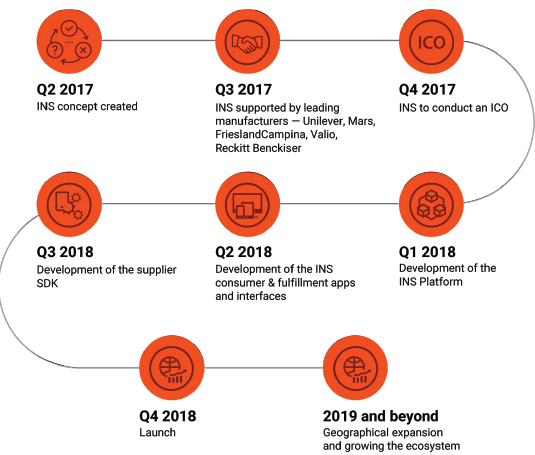
App and Web Interfaces Development App and web interfaces development is primarily about: -Front end development -Back-end development
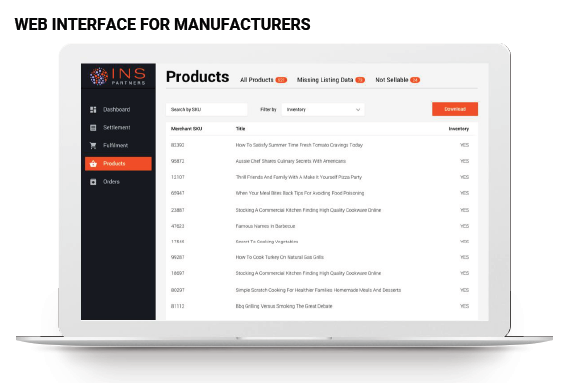
INS uses React and React Native technologies to develop app and web interfaces. An interesting insight about the web interface app – This app is for manufacturers and fulfillment centers. They need not download the app. It runs in the browser.
For more details visit:
Website:https://ins.world/
Twitter:https://twitter.com/ins_ecosystem
Telegram:https://t.me/ins_ecosystem
Whitepaper:https://ins.world/INS-ICO-Whitepaper.pdf
Written by : karanj
Btalk link:https://bitcointalk.org/index.php?action=profile;u=1030341